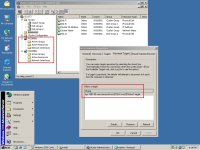Tell me what I want to do... please? ...
There are three Holy Grails in my humble opinion:
Fast Ethernet level of internet access
Browser that runs on 9x/NT that handles or gracefully fails when surfing the net
Multi-MB video in the 1440x900 resolution
... I guess I'm still a little confused about the system architecture here? It sounds like you're sitting there looking at a PS/2 (model?) that has a SCSI controller that you're hoping to somehow bridge to the Internet via the SCSI port instead of ethernet because in theory at least your SCSI port might be faster than the 1MB/s-ish you can get out of plain 10Mbit Ethernet, and that will let you surf the internet better?
SCSI can be used as a communications bus, Adaptec was thinking ahead. The early MACs used Ethernet over SCSI, but they had the 3MB or so transfer rate.
When 10Mbit ethernet came out, it was faster. But now we got Fast/Wide SCSI available, perhaps we can do much better?
Sure, you can drive pretty much whatever you want over SCSI; as you note yourself Ethernet adapters over SCSI were in fact a thing. But that doesn't mean that an iSCSI bridge is the same thing as a SCSI over Ethernet adapter.
Parallan made an external iPBridge, where the unit hooks up to the SCSI port, does whatever to the SCSI datastream, then fires iSCSI out over the integrated 10/100 Ethernet. Model 1550D? Hence my interest in the M$ Initiator...
These things? (ATTO made similar devices.) So... sure, these exist, but I'm very unclear on how they fit into the plan of making a PS/2 surf the web faster. These devices are designed to plug into a chain of SCSI storage devices in place of a computer host adapter and expose the storage devices behind it as LUNs on a single iSCSI target or a separately named iSCSI targets per device (per the ATTO manual), allowing commands to be sent to these devices from computers out there on the ethernet LAN via the iSCSI initiator software. Now, sure, there's nothing preventing you in theory at least from connecting one of these devices to a computer with a SCSI host adapter in it and advertising that SCSI ID as an iSCSI target, but... remember, all the bridge is capable of is taking SCSI traffic from the SCSI wire, stuffing it into an Ethernet packet, and slapping a header on the outside of it that'll route it to an iSCSI initiator that the bridge thinks will want it. Which means that if you try writing some kind of TCP/IP stack for the computer sitting on the SCSI chain that tried to use the bridge as if it were a SCSI Ethernet adapter that isn't going to work, because the bridge
only knows how to send that traffic to an initiator. It's not going to "magically" turn SCSI traffic into ethernet packets that can independently be routed to other ethernet destinations, nor is it going to proxy arp or whatever for incoming IP traffic destined for your PC behind it; the only incoming packets it'll be listening for are iSCSI packets.
So... sure, this still isn't an absolute deal killer: you could take your PS/2, put it behind the hardware bridge, write some kind of TCP stack that can encapsulate data packets into SCSI transactions, and then run an initiator on a more modern computer somewhere else on the network that can initiate the connection to the PS/2's advertised iSCSI LUN and from that point do the work of bridging the iSCSI-encapsulated IP packets onto the Ethernet network. (IE, traffic will essentially be U-turning through this companion machine.) It's definitely technically... possible. But if this is what you want you're still not going to be needing iSCSI initiator software for the PS/2, you'll need that SCSI-bridge TCP stack/network driver. Not sure where you're going to find that off the shelf.
(FWIW, if you're going to need a separate computer to do the SCSI bridging anyway, maybe forget the iSCSI bridge and just slap a parallel SCSI host adapter with reassignable addressing in that computer? The iSCSI bridge doesn't accomplish much of anything other than letting you put the PS/2 farther from its bridge?)
Anyway. Honestly, for any PS/2 ever made I'd wager a 10baseT ethernet card is going to be the
least of your roadblocks in trying to make the thing perform meaningfully well on the modern Internet.


